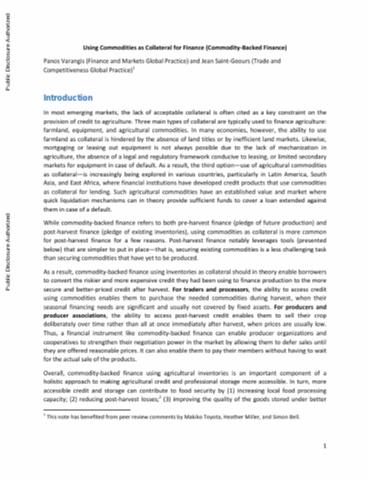Resource information
In most emerging markets, the lack of acceptable collateral is often cited as a key constraint on the provision of credit to agriculture. Three main types of collateral are typically used to finance agriculture: farmland, equipment, and agricultural commodities. In many economies, however, the ability to use farmland as collateral is hindered by the absence of land titles or by inefficient land markets. Likewise, mortgaging or leasing out equipment is not always possible due to the lack of mechanization in agriculture, the absence of a legal and regulatory framework conducive to leasing, or limited secondary markets for equipment in case of default. As a result, the third option, use of agricultural commodities as collateral, is increasingly being explored in various countries, particularly in Latin America, South Asia, and East Africa, where financial institutions have developed credit products that use commodities as collateral for lending. Such agricultural commodities have an established value and market where quick liquidation mechanisms can in theory provide sufficient funds to cover a loan extended against them in case of a default. Overall, commodity-backed finance using agricultural inventories is an important component of a holistic approach to making agricultural credit and professional storage more accessible. In turn, more accessible credit and storage can contribute to food security by: (1) increasing local food processing capacity; (2) reducing post-harvest losses;2 (3) improving the quality of the goods stored under better conditions; and (4) potentially improving incomes for farmers (through a combination of lower postharvest losses and better prices from delayed marketing).


